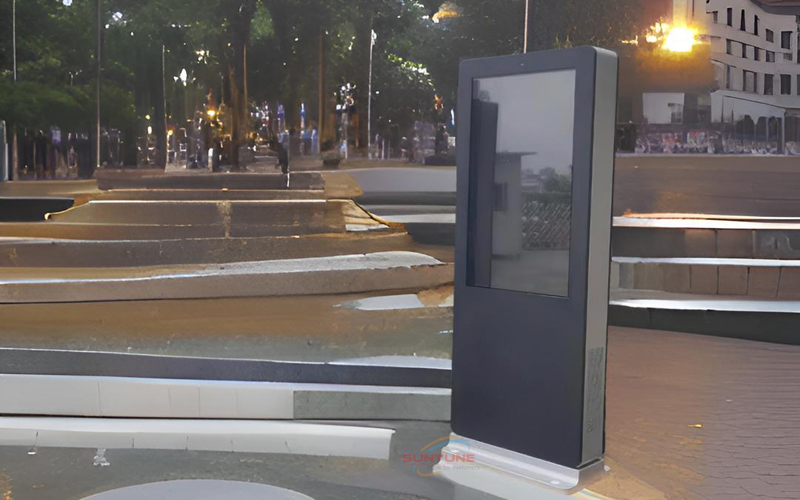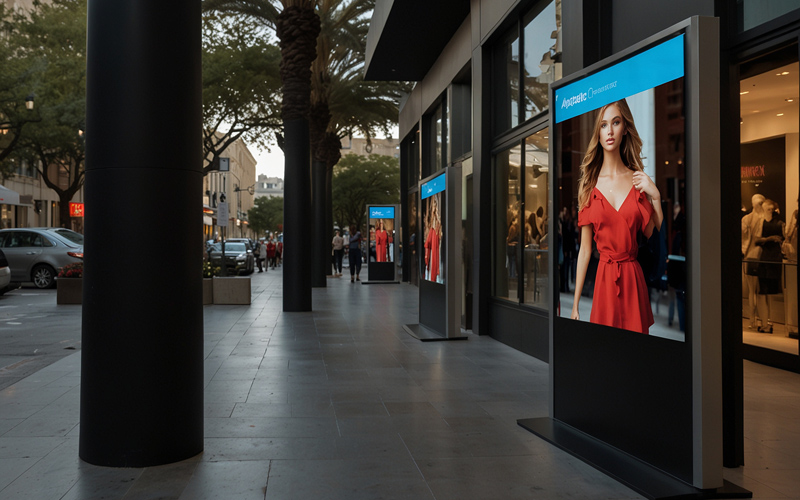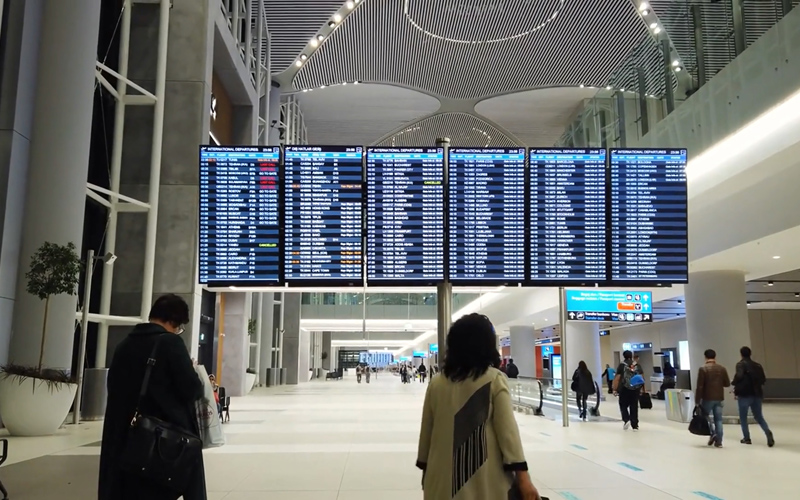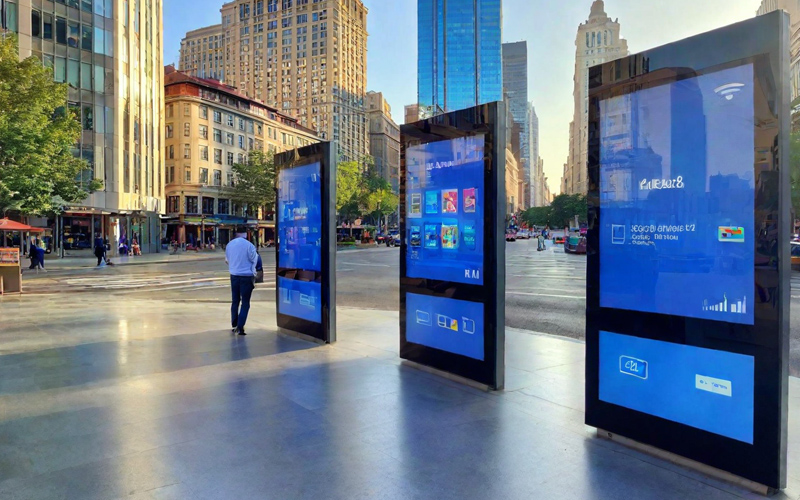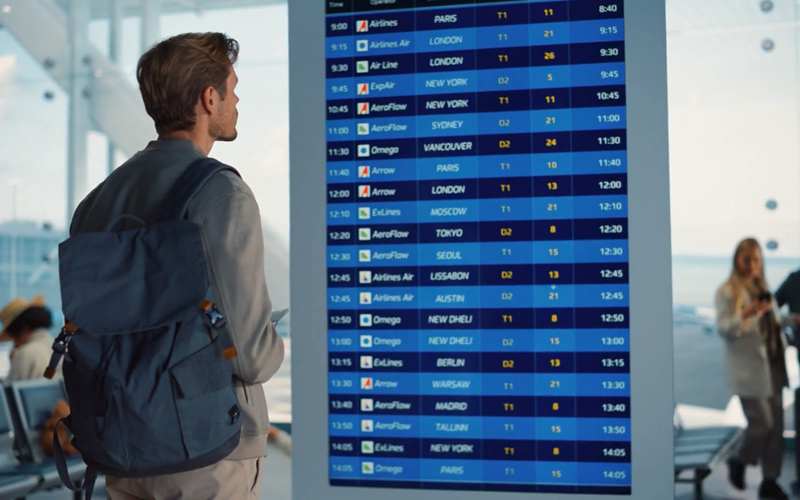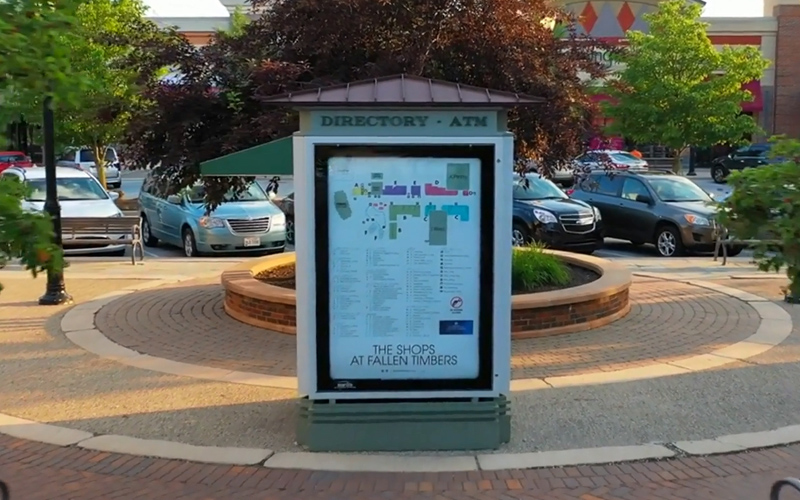As the digital landscape continues to evolve, the need for effective and engaging digital signage solutions has become increasingly crucial for businesses across various industries. Dynamic display management, a powerful tool in this realm, empowers organizations to seamlessly manage and control their digital content, ensuring a captivating and impactful visual experience for their audiences.
In this comprehensive guide, we will explore the intricacies of dynamic display management, delving into the benefits, the different types of content distribution platforms, and the cutting-edge features that can elevate your digital signage strategy to new heights.
Understanding the Benefits of Dynamic Display Management
Dynamic display management offers a multitude of advantages that can transform the way you engage with your audience. By leveraging this powerful technology, you can:
1. Enhance Audience Engagement: Captivating and interactive content can significantly improve audience attention and retention, leading to better brand recall and increased customer engagement.
2. Streamline Content Delivery: Centralized content management and real-time synchronization ensure that your digital displays are always up-to-date, eliminating the need for manual updates and reducing the risk of outdated information.
3. Improve Operational Efficiency: Automated content scheduling, remote deployment, and comprehensive analytics empower you to optimize your digital signage network, resulting in cost savings and improved overall performance.
4. Boost Brand Visibility: Dynamic, eye-catching displays can elevate your brand’s presence and create a lasting impression on your target audience, driving increased brand recognition and recall.
5. Personalize the Experience: Integrating audience analytics and interactive features allows you to tailor your content and messaging to specific demographics, enhancing the relevance and impact of your digital signage.
Exploring the Different Types of Content Distribution Platforms
When it comes to dynamic display management, there are various content distribution platforms to consider, each with its own unique features and capabilities. Some of the most prominent options include:
1. Cloud-Based Content Management Systems: These platforms offer centralized control over your digital content, allowing you to access, update, and deploy your displays from anywhere with an internet connection.
2. On-Premise Content Servers: For organizations that prefer to maintain local control over their digital signage infrastructure, on-premise content servers provide a robust and secure solution for content management and distribution.
3. Hybrid Approaches: Combining the benefits of cloud-based and on-premise solutions, hybrid models offer the flexibility to leverage both remote and local content management capabilities, depending on your specific needs.
4. Networked Digital Signage Platforms: These solutions enable seamless integration and synchronization across multiple displays, ensuring a cohesive and consistent visual experience throughout your digital signage network.
Multi-Screen Management Tools: Enhancing Digital Signage Efficiency
Effective digital signage management often requires the ability to control and coordinate multiple screens simultaneously. Multi-screen management tools provide the necessary functionality to streamline this process, allowing you to:
Centralize Content Management: Manage and distribute content across your entire digital signage network from a single, intuitive interface.
Synchronize Content Playback: Ensure that your displays are presenting the same or complementary content in a synchronized manner, creating a cohesive visual experience.
Optimize Screen Layouts: Easily configure and adjust the layout and positioning of content on individual screens or across multiple displays.
Monitor Network Performance: Gain real-time insights into the status and performance of your digital signage network, enabling proactive maintenance and troubleshooting.
Interactive Content Solutions: Engaging Your Audience
To captivate and engage your audience, dynamic display management solutions often incorporate interactive content features, such as:
1. Touchscreen Interactivity: Allow users to directly interact with your digital displays, enabling them to explore content, access information, and even complete transactions.
2. Gesture-Based Controls: Leverage advanced technologies like motion sensors and facial recognition to enable intuitive, hands-free interaction with your digital signage.
3. Integrated Mobile Experiences: Seamlessly integrate your digital signage with mobile devices, enabling users to access additional content, personalize their experience, or even control the displays remotely.
4. Gamification and Contests: Incorporate interactive elements like games, quizzes, and contests to encourage audience participation and create a memorable, engaging experience.
By leveraging these interactive capabilities, you can transform your digital signage into a dynamic, user-centric platform that fosters deeper engagement and stronger connections with your audience.
Real-Time Content Synchronization: Keeping Your Displays Up to Date
In the fast-paced digital landscape, the ability to maintain up-to-date and relevant content on your displays is crucial. Dynamic display management solutions often incorporate real-time content synchronization features, enabling you to:
Instantly Update Content: Quickly make changes to your digital content and have those updates reflected across your entire signage network in real-time.
Schedule Content Campaigns: Develop and schedule content campaigns with precise timing, ensuring that your displays present the right information at the right time.
Leverage Live Data Feeds: Integrate your digital signage with live data sources, such as news, weather, or stock market updates, to provide your audience with the most current information.
Implement Emergency Messaging: Rapidly deploy urgent or time-sensitive messages across your digital signage network, ensuring that your audience receives critical updates in a timely manner.
By keeping your content fresh and responsive, you can maintain the attention and trust of your audience, strengthening your brand’s reputation and credibility.
Customizable Content Templates: Designing Eye-Catching Displays
Creating visually appealing and impactful digital content is a crucial aspect of effective dynamic display management. Many solutions offer a range of customizable content templates that allow you to:
1. Easily Design and Modify Content: Leverage pre-designed templates or create your own layouts, incorporating various multimedia elements like images, videos, and animations.
2. Maintain Brand Consistency: Ensure that your digital signage aligns with your brand’s visual identity, using custom colors, logos, and design elements.
3. Optimize Content for Different Screen Sizes: Easily adapt your content to fit a variety of display sizes, from smaller screens to large-scale video walls, without compromising the quality or layout.
4. Incorporate Dynamic Content Elements: Leverage features like scrolling tickers, countdown timers, and real-time data visualizations to create engaging and informative displays.
By utilizing customizable content templates, you can streamline the content creation process, maintain brand cohesion, and deliver visually stunning digital signage experiences that captivate your audience.
Cloud-Based Content Management: Accessing and Controlling Your Content Anywhere
Cloud-based content management systems have become a popular choice for dynamic display management, offering a range of benefits:
1. Remote Access and Control: Manage your digital content, schedule updates, and monitor your signage network from anywhere with an internet connection, providing unparalleled flexibility and convenience.
2. Scalable Storage and Processing: Cloud-based platforms offer virtually limitless storage and computing power, allowing you to easily accommodate growing content libraries and network expansions.
3. Automatic Software Updates: Enjoy seamless software updates and maintenance, ensuring that your digital signage solution is always up-to-date and secure, without the need for manual intervention.
4. Collaborative Content Creation: Enable multiple team members to access, edit, and approve digital content in real-time, streamlining the content development and approval process.
5. Enhanced Data Security: Leverage the robust security features of cloud-based platforms, which often include data encryption, redundant backups, and advanced access controls, to protect your sensitive information.
By embracing cloud-based content management, you can unlock the full potential of your dynamic display management strategy, empowering your team to work seamlessly and efficiently, regardless of their physical location.
Integrating Audience Analytics: Gaining Insights and Improving Targeting
Effective dynamic display management goes beyond just content delivery; it also involves understanding your audience and their preferences. By integrating audience analytics into your digital signage solution, you can:
1. Measure Engagement Metrics: Gather data on metrics such as dwell time, interaction rates, and content engagement, providing valuable insights into how your audience is interacting with your digital displays.
2. Identify Audience Demographics: Leverage advanced analytics tools, including facial recognition and heat mapping, to gain a deeper understanding of your audience’s age, gender, and other relevant characteristics.
3. Optimize Content Targeting: Use the insights gathered from audience analytics to tailor your content and messaging to specific demographic groups, ensuring maximum relevance and impact.
4. Measure Campaign Effectiveness: Evaluate the performance of your digital signage campaigns, allowing you to make data-driven decisions and continually refine your strategy for better results.
5. Enhance the Customer Experience: By understanding your audience’s preferences and behavior, you can create more personalized and engaging digital signage experiences, fostering stronger connections with your customers.
Integrating audience analytics into your dynamic display management solution empowers you to make informed decisions, optimize your content delivery, and continuously improve the effectiveness of your digital signage initiatives.
Remote Content Deployment: Streamlining Display Management
In today’s fast-paced business environment, the ability to manage your digital signage network remotely has become increasingly important. Dynamic display management solutions often incorporate remote content deployment features, enabling you to:
1. Centralize Content Updates: Make changes to your digital content from a single, centralized location and have those updates automatically distributed to all connected displays.
2. Reduce Onsite Maintenance: Minimize the need for on-site technicians or IT staff to manually update or troubleshoot individual displays, saving time and resources.
3. Respond Quickly to Changing Needs: Rapidly deploy new content, adjust schedules, or address any issues that arise, ensuring your digital signage remains relevant and up-to-date.
4. Manage Geographically Dispersed Networks: Efficiently control and monitor your digital signage network, regardless of the physical location of your displays, making it an ideal solution for multi-site or franchise-based organizations.
5. Implement Automated Workflows: Leverage scheduling and content management tools to create automated content deployment workflows, further streamlining the management of your digital signage network.
By embracing remote content deployment capabilities, you can enhance the efficiency and responsiveness of your dynamic display management strategy, ensuring that your digital signage remains a powerful and valuable asset for your organization.
Scalable Digital Signage Solutions: Growing Your Network
As your business or organization grows, the ability to scale your digital signage network becomes increasingly important. Dynamic display management solutions often offer scalable features that allow you to:
1. Expand Your Network: Seamlessly add new displays, screens, or even entire locations to your digital signage network, without disrupting the existing infrastructure or functionality.
2. Manage Increased Content Demands: Accommodate the growing needs of your organization, whether it’s a larger content library, more frequent updates, or the integration of new data sources.
3. Leverage Centralized Control: Maintain a unified, centralized management system that can effectively coordinate and control your expanding digital signage network, ensuring consistent brand messaging and user experience.
4. Optimize Resource Allocation: Efficiently allocate hardware, software, and IT resources to support the growth of your digital signage network, maximizing your investments and minimizing operational costs.
5. Ensure Reliable Performance: Maintain the stability and responsiveness of your digital signage network, even as it grows in size and complexity, through robust system architecture and failover mechanisms.
By choosing a scalable dynamic display management solution, you can future-proof your digital signage investments, allowing your network to grow and evolve alongside your business, without compromising performance or functionality.
Optimizing Display Networks: Ensuring Smooth and Reliable Performance
Maintaining the smooth and reliable performance of your digital signage network is crucial for delivering a consistent and engaging experience to your audience. Dynamic display management solutions often incorporate features and tools to optimize network performance, such as:
1. Remote Monitoring and Diagnostics: Continuously monitor the health and status of your displays, allowing you to quickly identify and address any issues that may arise.
2. Automated Failover and Redundancy: Implement failover mechanisms and redundant hardware to ensure uninterrupted content playback, even in the event of a system or hardware failure.
3. Content Caching and Offline Playback: Enable your displays to cache content locally, ensuring that they can continue to operate and present information in the event of a network disruption.
4. Network Bandwidth Management: Optimize the distribution of content across your network, prioritizing critical data and adjusting bandwidth allocation to maintain smooth playback and minimize latency.
5. Proactive Maintenance and Updates: Receive timely alerts and recommendations for software updates, hardware maintenance, and other preventive measures to maintain the long-term reliability and performance of your digital signage network.
By implementing these optimization strategies, you can ensure that your digital signage network operates seamlessly, delivering a consistently high-quality experience to your audience and minimizing the risk of downtime or disruptions.
Content Automation Systems: Simplifying Content Updates
Keeping your digital signage content fresh and engaging can be a time-consuming task, especially as your network grows. Dynamic display management solutions often incorporate content automation systems to streamline this process, allowing you to:
1. Automate Content Scheduling: Create and schedule content playlists that automatically update and rotate based on predefined schedules, ensuring that your displays always present the most relevant information.
2. Integrate with Data Sources: Seamlessly connect your digital signage to live data feeds, such as news, weather, or social media, enabling the automatic integration of real-time updates and information.
3. Leverage Template-Based Workflows: Develop customizable content templates that can be easily updated and deployed across your entire signage network, reducing the time and effort required for content creation and updates.
4. Implement Content Approval Processes: Establish collaborative workflows that allow multiple stakeholders to review, approve, and publish content, ensuring brand consistency and compliance.
5. Receive Automated Alerts: Set up notifications to alert you of any content updates, scheduled changes, or potential issues, allowing you to stay informed and responsive.
By incorporating content automation systems into your dynamic display management strategy, you can streamline the content creation and distribution process, freeing up your team to focus on more strategic initiatives and delivering a consistently engaging digital signage experience.
Digital Signage Content Creation: Best Practices and Tools
Crafting visually appealing and effective digital signage content is a crucial component of a successful dynamic display management strategy. Here are some best practices and tools to consider:
1. Utilize Design Templates: Leverage pre-designed templates or create custom templates that align with your brand’s visual identity, ensuring a cohesive and professional look across your digital signage network.
2. Incorporate Multimedia Elements: Combine a variety of media, such as images, videos, animations, and graphics, to create dynamic and engaging content that captures your audience’s attention.
3. Optimize for Different Screen Sizes: Ensure that your content is adaptable and can be easily scaled to fit a range of display sizes, from smaller screens to large-format video walls.
4. Leverage Content Automation Tools: Integrate your digital signage with content creation and management platforms, such as Adobe Creative Cloud or Canva, to streamline the design and publishing process.
5. Collaborate with Designers and Subject Matter Experts: Collaborate with in-house or external design teams, as well as subject matter experts, to create visually stunning and informative content that resonates with your target audience.
6. Continually Test and Iterate: Regularly evaluate the performance and engagement of your digital signage content, and make iterative improvements based on audience feedback and data-driven insights.
By following these best practices and utilizing the right tools, you can elevate the quality and impact of your digital signage content, captivating your audience and driving meaningful engagement with your brand.
Video Wall Management Software: Creating Stunning Visual Experiences
For organizations seeking to create truly immersive and impactful digital signage experiences, video wall management software can be a powerful tool within a dynamic display management strategy. These specialized solutions offer:
1. Seamless Content Synchronization: Ensure that content is displayed seamlessly across multiple screens, creating a cohesive and visually stunning video wall experience.
2. Advanced Layout and Configuration: Easily configure the layout, aspect ratio, and placement of content on your video wall, tailoring the display to your specific needs.
3. Real-Time Content Control: Dynamically adjust and manipulate the content on your video wall, enabling you to respond to changing audience preferences or evolving business requirements.
4. Integrated Analytics and Monitoring: Gain insights into audience engagement and the performance of your video wall, allowing you to optimize content and measure the impact of your digital signage initiatives.
5. Scalable and Flexible Architecture: Accommodate the growth and expansion of your video wall infrastructure, seamlessly integrating with your existing digital signage management system.
By leveraging video wall management software within your dynamic display management strategy, you can create awe-inspiring visual experiences that captivate your audience and elevate your brand’s presence in the digital landscape.
Content Playlist Scheduling: Ensuring Timely and Relevant Content
Effective content scheduling is a crucial component of dynamic display management, ensuring that your digital signage presents the right information at the right time. Many solutions offer advanced content playlist scheduling features, enabling you to:
1. Develop Customized Playlists: Create an Develop Customized Playlists: Create an unlimited number of content playlists, each tailored to specific time slots, locations, or audience segments, ensuring that your displays present the most relevant and engaging content.
2. Implement Automated Scheduling: Leverage scheduling tools to automate the rotation and timing of your content playlists, eliminating the need for manual updates and ensuring consistent delivery of information.
3. Prioritize Time-Sensitive Content: Easily integrate and prioritize time-sensitive or emergency content, ensuring that critical updates and announcements are displayed promptly and prominently.
4. Optimize Playlist Performance: Analyze audience engagement metrics and adjust your content playlists accordingly, continuously improving the effectiveness of your digital signage.
5. Streamline Playlist Management: Centralize the management and distribution of your content playlists, making it easy to update, modify, or deploy changes across your entire digital signage network.
By implementing advanced content playlist scheduling capabilities, you can ensure that your digital signage remains a dynamic and engaging platform, captivating your audience with timely and relevant content.
Touchscreen Interface Design: Enhancing User Interaction
To create truly immersive and interactive digital signage experiences, the design of the touchscreen interface plays a crucial role. Dynamic display management solutions often incorporate features and best practices for optimizing touchscreen interactions, such as:
Intuitive Navigation: Develop a touchscreen interface that is easy to navigate, with clear and logical menu structures, allowing users to intuitively explore and interact with your digital content.
Responsive Design: Ensure that your touchscreen interface is designed to be responsive and seamless, with quick reaction times and smooth transitions between screens or actions.
Accessibility Considerations: Incorporate accessibility features, such as large, easy-to-read text, high-contrast color schemes, and alternative input methods, to accommodate users with diverse needs and abilities.
Personalization Options: Enable users to customize their experience by saving preferences, bookmarking content, or accessing personalized information, fostering a sense of ownership and engagement.
Contextual Guidance: Provide clear instructions, tooltips, or interactive tutorials to guide users through the touchscreen interface, enhancing their understanding and comfort with the interactive features.
By focusing on the design and usability of your touchscreen interface, you can create a digital signage experience that is intuitive, engaging, and accessible to a wide range of users, ultimately driving higher levels of interaction and audience satisfaction.
Choosing the Right Dynamic Display Management Solution
As you navigate the dynamic display management landscape, it’s essential to carefully evaluate the features, capabilities, and scalability of the available solutions to ensure that you select the one that best aligns with your organization’s needs and goals.
When evaluating dynamic display management solutions, consider factors such as:
1. Content Management Capabilities: Assess the platform’s ability to centralize, schedule, and distribute content across your digital signage network, ensuring seamless and efficient content updates.
2. Audience Engagement Features: Prioritize solutions that offer interactive capabilities, personalization options, and audience analytics to enhance the user experience and drive deeper engagement.
3. Scalability and Flexibility: Look for a solution that can accommodate the growth and evolution of your digital signage network, allowing you to easily expand your infrastructure and adapt to changing requirements.
4. Integration and Compatibility: Ensure that the dynamic display management solution can seamlessly integrate with your existing technology ecosystem, including CMS platforms, data sources, and other business applications.
5. Reliable Performance and Support: Evaluate the solution’s track record for stability, uptime, and responsiveness, as well as the quality of the vendor’s customer support and maintenance services.
By carefully considering these factors and aligning the dynamic display management solution with your organization’s unique needs, you can unlock the full potential of digital signage, transforming your visual communication strategy and driving tangible business outcomes.




